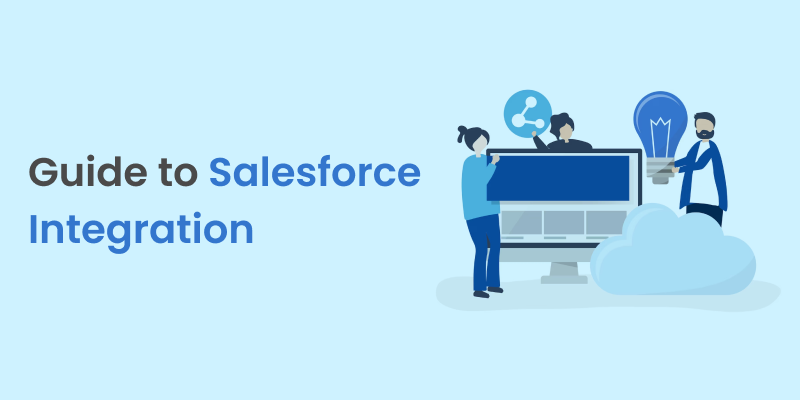Guide to Salesforce Integration

Welcome to the comprehensive guide unveiling the world of Salesforce integration—an indispensable process that transforms your business operations. Seamlessly amalgamating systems and data, this blog unveils the power of integrating Salesforce into your ecosystem. From unraveling integration types to demystifying benefits and best practices, embark on a journey that promises to elevate your business efficiency, customer experience, and overall success. Let’s delve into the realm of Salesforce integration and unlock unparalleled potential.
Alt text – Guide to Salesforce Integration
Before embarking on the comprehensive exploration of Salesforce integration, a foundational understanding of Salesforce’s core functionalities is recommended. Being a learner you can undergo some training to master the skills. Elevate your skills with comprehensive Salesforce Training, unlocking opportunities for a thriving career in the dynamic world of customer relationship management. Familiarity with cloud-based technologies, APIs, and data management concepts will enhance comprehension. This guide aims to demystify the intricacies of integrating Salesforce with various systems, enabling you to harness its full potential for streamlined operations and enhanced customer experiences. Approach with a willingness to grasp the nuances of seamless integration in the dynamic business landscape.
Why Integrate Salesforce with Other Systems?
The integration of Salesforce with other systems holds profound importance in the modern business landscape. The primary motivation behind this integration lies in the pursuit of operational efficiency, streamlined workflows, and enhanced customer experiences. By seamlessly connecting Salesforce with various complementary platforms, organizations can realize a multitude of benefits that contribute to their growth and success.
Integrating Salesforce allows for the seamless exchange of data between different departments and systems, eradicating data silos and promoting a unified view of customer interactions. This fosters better collaboration, as teams have access to accurate, up-to-date information that enables informed decision-making. Moreover, integration enables the automation of processes, reducing manual intervention and potential errors, thereby boosting productivity.
Another pivotal reason for integrating Salesforce is the enrichment of customer experiences. Businesses can tailor interactions based on individual preferences and history by integrating customer relationship data with marketing automation or customer service systems. This leads to personalized engagement, improved customer satisfaction, and higher retention rates.
Furthermore, integrating Salesforce with accounting, inventory, or e-commerce systems aids in seamless order processing, invoice management, and inventory updates. This enhances operational efficiency and ensures a smooth customer journey from order placement to delivery.
How to Choose the Right Integration Approach?
Selecting the appropriate integration approach is a critical decision for businesses aiming to optimize their systems, enhance workflows, and streamline operations. To choose the right approach, several factors warrant careful consideration.
- Business Goals and Needs: Begin by understanding your organization’s specific goals and needs. Assess whether you require real-time data synchronization, batch processing, or a combination of both. Align the integration approach with your objectives to ensure seamless functionality.
- Data Volume and Frequency: Analyze the volume of data you need to handle and the frequency of data transfers. Real-time integration suits scenarios demanding instant data updates, while batch integration might be preferable for larger data sets or less time-sensitive processes.
- Complexity of Systems: Evaluate the complexity of the systems you aim to integrate. For simpler integrations, point-to-point solutions could suffice. However, for intricate systems requiring multiple connections, middleware or API-based approaches might offer more flexibility.
- Scalability and Future Growth: Anticipate future growth and scalability requirements. Choose an approach that accommodates increased data loads and additional connections without significant disruptions.
- Cost and Resources: Factor in the costs associated with each integration approach, including implementation, maintenance, and potential training requirements. Assess your organization’s available resources and budget constraints.
- Security and Compliance: Consider data security and regulatory compliance. Ensure the chosen approach maintains data integrity, and confidentiality, and meets industry-specific compliance standards.
- Technical Compatibility: Assess the technical compatibility of your existing systems with the integration approach. Ensure the chosen solution seamlessly integrates with your technology stack.
- Vendor Support and Ecosystem: Research the vendors providing integration solutions. Opt for reputable vendors with a track record of providing support and a robust ecosystem of tools and resources.
- Future Adaptability: Choose an approach that remains adaptable to evolving technologies and market trends. The selected solution should offer room for innovation and future upgrades.
What Are the Key Steps to Successful Integration?
The key steps to achieve such integration revolve around a strategic and well-structured process.
- Comprehensive Assessment: Begin by conducting a thorough analysis of the entities or systems to be integrated. Understand their functionalities, requirements, and potential challenges to formulate a clear integration strategy.
- Clear Objectives: Define the goals and outcomes of the integration process. Establish specific, measurable, achievable, relevant, and time-bound (SMART) objectives that align with the overall organizational strategy.
- Strategic Planning: Develop a detailed integration plan outlining the sequence of activities, timeline, resource allocation, and responsibilities. Consider the impact on existing operations and identify potential risks.
- Technology Alignment: Ensure that the technologies being integrated are compatible and can communicate effectively. This may involve APIs, middleware, or custom development to bridge the gap between different systems.
- Data Mapping and Transformation: Map data elements between the integrated systems, addressing inconsistencies or disparities in data formats, structures, and semantics. Implement data transformation processes to facilitate seamless data exchange.
- Testing and Validation: Rigorous testing is critical to identify and rectify any integration issues. Perform unit, integration, and end-to-end testing to validate the accuracy, reliability, and functionality of the integrated solution.
- Change Management: Implement a well-defined change management strategy to prepare stakeholders for the integration process. This includes communication, training, and support to manage potential resistance or disruptions.
- Continuous Monitoring: After successful integration, establish mechanisms for ongoing monitoring and performance evaluation. Proactively address any emerging issues to ensure sustained functionality and value realization.
- Feedback Loop and Optimization: Encourage feedback from users and stakeholders to identify areas for improvement. Iteratively refine the integration process based on real-world experiences and changing needs.
What Are the Best Practices for Maintaining Integration?
Maintaining seamless integration within complex systems is pivotal for sustained operational efficiency and optimized performance. Embracing best practices for integration ensures consistent data flow, minimizes disruptions, and fosters a cohesive ecosystem.
Firstly, meticulous planning is paramount. Establish a comprehensive strategy that aligns with organizational objectives and anticipates future scalability. Secondly, adopt standardized protocols and APIs to facilitate interoperability between different components. This promotes smoother communication and data exchange.
Regular monitoring and proactive troubleshooting constitute another essential practice. Employ robust monitoring tools to identify potential bottlenecks, errors, or performance degradation promptly. Swiftly addressing these issues prevents cascading impacts on the integrated system.
Moreover, documentation plays a crucial role. Maintain detailed documentation of integration architecture, data mappings, and interfaces. This facilitates understanding, aids troubleshooting, and eases the onboarding of new team members.
Prioritize security measures. Implement encryption, access controls, and authentication mechanisms to safeguard data integrity and protect sensitive information during transit.
Lastly, ensure stakeholder collaboration. Foster open communication among teams responsible for various components to promptly address changes, updates, and potential issues.
Conclusion
In the dynamic landscape of modern business, mastering Salesforce Integration proves to be a pivotal step toward enhancing efficiency, connectivity, and customer experience. As you conclude this comprehensive guide, you’ve gained insights into the significance, methods, and benefits of seamless integration. The future scope holds promises of further innovation and streamlining operations.
To dive deeper, explore advanced integration techniques, harness the power of automation, and delve into real-world case studies that highlight successful integration strategies. Embrace the evolving potential of Salesforce Integration to propel your business toward greater heights of success and competitiveness in the digital age.





